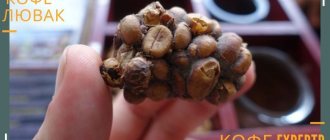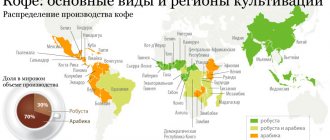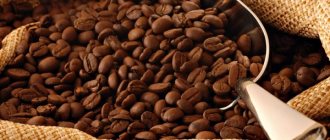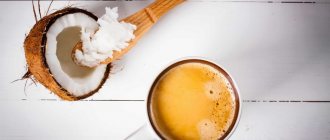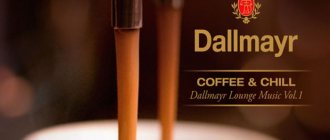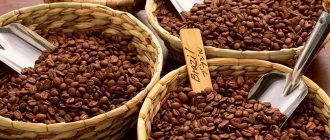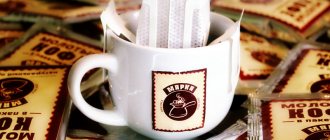Hawaii is the world's only coffee-producing country in the developed world. This fact affects both the economics of the industry and the marketing associated with local coffee. Hawaiian producers have been able to establish a direct connection with consumers, with the purchase of beans often accompanied by visits to the islands, but many experts realize that quality is not always justified by price.
At the end of the 19th century, immigrants from China and then Japan began to arrive en masse to work on the plantations. In the 1920s, Filipinos began arriving to work on coffee farms during the harvest season and in the spring on sugar cane plantations. Coffee only became an important crop for the islands in the 1980s, when the sugar industry ceased to generate much income. This revived interest in coffee.
History of Coffee in Hawaii
Coffee was introduced to Hawaii in 1817, but the first seedlings did not take root. In 1825, the governor, Chief of Oahu Boki, returning from a trip to Europe, made a stop in Brazil and brought from there several coffee trees. These plants produced a good harvest, and soon they spread throughout Hawaii. Bourbon was most likely brought to the Big Island in 1828. The first commercial plantation appeared on the island of Kauai in 1836. However, coffee trees on a plantation in the Hanalei Valley on Kauai were killed by coffee rust in 1858. Only the Kona region on the Big Island retains the original plantations.
Modern production
The "coffee belt" in the Kona region (Kona (coffee), Hawaii (county)) is several kilometers wide at altitudes of 200-600 meters above sea level.
Other coffee-growing areas on the island include Kau in the south of the island of Hawaii, Puna in the southeast, and Hamakua in the northeast.[11]
Although coffee can be harvested year-round in Hawaii, production is highest in late summer and extends into early spring.
In 2008-2009, there were about 790 farms on the island of Hawaii and 40 on the other islands. About 3,200 hectares are planted with coffee throughout the state of Hawaii. Slightly more than half of the areas are located outside the island of Hawaii, specifically on the island of Kauai[12].
Several former sugarcane and pineapple plantations have switched production to coffee, such as Molokai coffee.
Kona
The most famous coffee region of the Hawaiian Islands and one of the most famous in the world is Kona, located on the Big Island. The region's long history of cultivation has given it a good reputation, but this success has also led to many counterfeits. Current island law requires that every blend of Kona coffee be labeled with the quantity and trademark “100% Kona.” Previously, a California farm called Kona Kai had fought for permission to use any trademarks and protection of the name, but in 1996 the manager of this farm was found guilty of filling bags labeled as Kona coffee with beans from Costa Rica. The region has recently been plagued by the coffee beetle. The island successfully fought it off, but many feared that the reduction in harvest would lead to further increases in already high prices.
Coffees of Hawaii – Natural Hawaiian coffee
- Great evening, maybe we should come to my place for coffee? - Well, I don’t even know, coffee at night somehow... - Well, please! I haven't had coffee for six months! Why did I remember this anecdote? Yes, you were right: we will talk about exactly what you were thinking about - real Hawaiian coffee 
The Hawaiian Islands are the largest volcanic archipelago in Polynesia, located in the central Pacific Ocean, consisting of twenty-four islands and atolls. Most of the islands of the archipelago make up the youngest - the fiftieth US state of Hawaii. Hawaii is the only North American state with the climate conditions necessary for growing coffee. The combination of rich volcanic soil, year-round warm climate with abundant rainfall creates favorable conditions for growing high-quality coffee.
The best varieties of elite natural Hawaiian coffee - according to its own assurances - are offered by Coffees of Hawaii. The names of the varieties come from the names of the Hawaiian islands and cities.
In order to get acquainted with the main varieties of coffee sold and decide on priorities, the company offers sets of “samplers” - this is what you need! I chose a few pieces of each of the two sets offered at the time of purchase, because... they are “gift” packaged and can serve as good souvenirs and small gifts.
The first one is called “Sampler Box – 1 Island”:
3 samples of Molokai Arabica from the island of the same name: “Hawaiian Espresso Moloka'I Style” dark roast “Intense Power” (for espresso, latte, mocha, cappuccino or American), “Malulani Estate” medium roast “Peaceful Power” and “Moloka' i Muleskinner" dark roast "Rough Country".
Second “Sampler Box – 3 Island”:
Kona Nightingale Dark Roast Moonlit Water, Maui Pohaku o Ka'anapali Medium Roast Friendly Rivalry, and Molokai Hawaiian Espresso Moloka'I Style Dark Roast (same as the first set) .
Each set contains 3 bags of 2 oz (57 g), i.e. only 170 g. The first costs $12.64, the second $13.75. By the way, now the number of “sample” sets has increased by another 2 (they have 4 samples each). Payment can be made either by card or via PayPal. The site is well Russified. Shipping is free, but there is a $10 service fee per order for international shipping. (Now - $20!) Oh, by the way, any coffee can be ordered both beans and ground (several types of professional grinding are offered depending on the type of coffee). For those who have parcels from abroad delivered quickly, it makes sense to order ground coffee. Due to the fact that parcels reach me extremely slowly, I ordered in beans: I was afraid that all the aroma and taste would disappear during the long journey (postal workers would smell it). I don't know if it's a coincidence or not, but my order was in processing status for a week. Unable to bear it, I wrote to them by email. A few minutes later the manager replied that the order would be sent this morning (they had 9 am). Indeed, an hour later I received confirmation that the order had been sent with two track numbers (more on them below). The first one immediately tracked down at the reception. If you want to chat, pay attention to the “unusual” time in Hawaii: GMT-10.00 (i.e. minus 14 hours from Moscow time). Their logistics are unique: from Hawaii, the parcel was first sent by FedEx to Newark, New Jersey (east coast!) - with detailed tracking using the FedEx track number. Got there in less than two days. Then the parcel was sent by Swedish Post using a new track number (customs in Moscow). The entire journey took 24 days.
I will not agitate anyone, I will not talk for a long time about the deep rich taste, delicate soft aroma, rich shades, etc., etc. – as they say, all markers have different tastes and colors...
Let me say briefly: I really liked the coffee (I brew it in a copper pot). It is truly aromatic and very tasty, truly natural and well prepared.
I wholeheartedly advise you to try this coffee! I will continue to order Hawaiian coffee in the future.
Thank you for your attention!
Bon appetit!
PS Yes, indeed the “service fee” was raised to $20. Of course, with the following logistics: transport it from the Pacific Ocean across the entire US territory to the east, then by plane to Europe. Although it is much easier to go straight to the west - to Japan, Korea or our Far East. It looks like it will have to be via mail forwarding.
Growing regions
Population: 1,400,000
Number of bags (60 kg): 43,181
The reputation of the Hawaiian Islands as a whole is built on the products of one region: Kona. Coffees from other islands are also worth trying if you like typical island coffees that are relatively low in acidity, light in body, and lightly fruity.
Kauai Island
Production on the island is almost entirely owned by one company, which owns 1,250 hectares of land planted with coffee - The Kauai Coffee Company. Due to the large size of the farms here, they are highly mechanized.
Height: 30-180 m
Harvest: October - December
Varieties and varieties: Yellow Catuai, Red Catuai, Tu pica, Blue Mountain, Mundo Novo
Oahu Island
Another island dominated by Waialua Estate with an area of about 60 hectares. This farm, which began growing coffee in the early 1990s, has fully mechanized its production and now also grows cocoa.
Height: 180-210 m
Harvest: September - February
Varieties and varieties: Typica
Maui Island
There is one large commercial farm on Maui, Ka'anapali, where anyone can buy a piece of land with a house or a plot of coffee plantation. Although the farm's plots have different owners, coffee production is centralized.
Height: 100-550 m
Harvest: September - January
Varieties and varieties: Red Catuai, Yellow Caturra, Typica, Mocha
Kula (Maui)
In this small region, coffee trees grow on the slopes of the Haleakala volcano, which provides a good height for the trees to grow. Coffee began to be grown here relatively recently.
Height: 450-1050 m
Harvest: September - January
Varieties and varieties: Typica, Red Catuai
Waikapu (Maui Island)
This coffee region is a newcomer. There is only one farm here, owned by a company from the neighboring island of Molokai, Coffees of Hawaii.
Height: 500-750 m
Harvest: September - January
Varieties and varieties: Typica, Catuai
Kipahulu (Maui)
A nearly flat region on the southeast coast of Maui. Coffee is often grown on organic farms along with other crops.
Height: 90-180 m
Harvest: September - January Varieties and varieties: Typica, Catuai
Kaulapuu (Molokai Island)
The region is also dominated by Coffees of Hawaii. This large farm is mechanized because labor is very expensive on the island.
Height: 250 m
Harvest: September - January
Varieties and varieties: Red Catuai
Kona (big island)
Unlike other regions of the Hawaiian Islands, the economy here is more diverse: over 630 farms produce coffee. As a rule, they are managed by individual families, their area does not exceed 2 hectares, and the crops are harvested by hand.
Height: 150-900 m
Harvest: August - January
Varieties and varieties: Typica
Kau (big island)
Coffee production in this region began relatively recently, following the closure of a sugar factory in 1996. And in 2010, they built their own processing station in the region.
Height: 500-650 m
Harvest: August - January
Varieties and varieties: Typica
Pune (big island)
At the end of the 19th century, about 2,400 hectares of land were planted with coffee trees, but coffee production gave way to sugar cane. After the sugar factory closed in 1984, some farmers returned to coffee. Most farms in the region are small, 1.2 hectares.
Height: 300-750 m
Harvest: August - January
Varieties and varieties: Red Catuai, Typica
Features of the technology
Kona coffee trees bloom in February-March, covered with snow-white flowers, fruits appear in April, and in August-September it is already possible to harvest coffee cherries. From one tree you can get up to 7 kg of berries, which will turn into approximately 1 kg of roasted beans.
Arabica Kona is processed using the wet method: the fruits are peeled and pulped, then left for 12-24 hours. During this time, the remaining pulp is fermented, after which it is washed off with water. The grains are dried in the fresh air for 7-14 days, so that their moisture content does not exceed 10-13%.
Characteristics of the Kona variety
The Kona bouquet reveals notes of brown sugar, milk chocolate, honey and fruit. This coffee has a bright taste, velvety texture and full body. Other types of Hawaiian coffee are more “floral” - they contain tones of rose, orange, blackberry and molasses.
Coffee production was also attempted in California and Florida, but the results were not of high quality and never made it to market.
